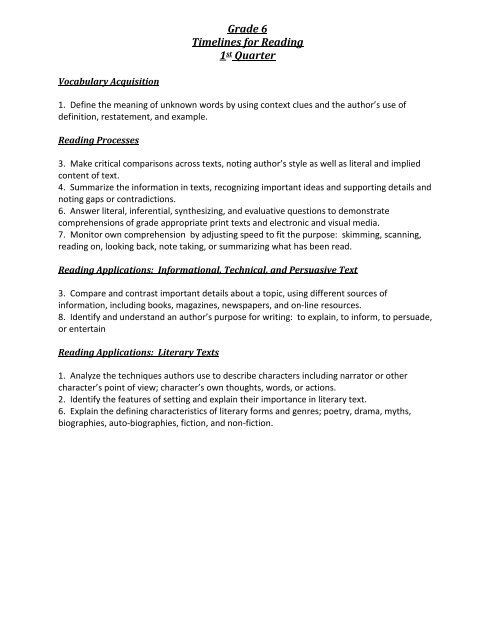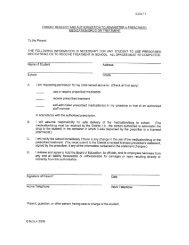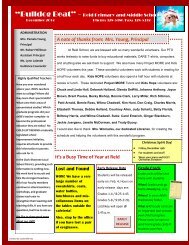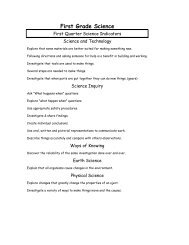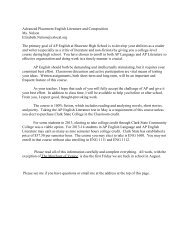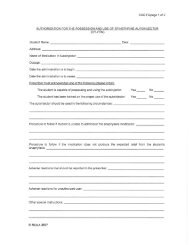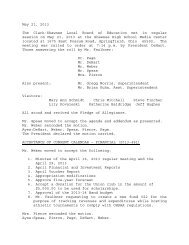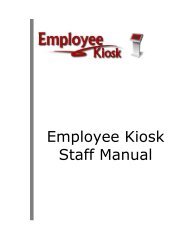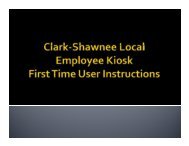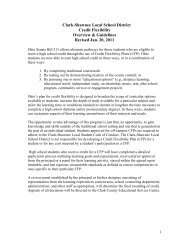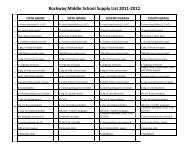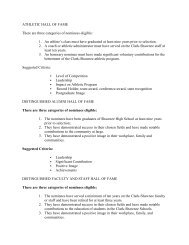Grade 6 Timelines for Reading 1st Quarter
Grade 6 Timelines for Reading 1st Quarter
Grade 6 Timelines for Reading 1st Quarter
Create successful ePaper yourself
Turn your PDF publications into a flip-book with our unique Google optimized e-Paper software.
<strong>Grade</strong> 6<br />
<strong>Timelines</strong> <strong>for</strong> <strong>Reading</strong><br />
1 st <strong>Quarter</strong><br />
Vocabulary Acquisition<br />
1. Define the meaning of unknown words by using context clues and the author’s use of<br />
definition, restatement, and example.<br />
<strong>Reading</strong> Processes<br />
3. Make critical comparisons across texts, noting author’s style as well as literal and implied<br />
content of text.<br />
4. Summarize the in<strong>for</strong>mation in texts, recognizing important ideas and supporting details and<br />
noting gaps or contradictions.<br />
6. Answer literal, inferential, synthesizing, and evaluative questions to demonstrate<br />
comprehensions of grade appropriate print texts and electronic and visual media.<br />
7. Monitor own comprehension by adjusting speed to fit the purpose: skimming, scanning,<br />
reading on, looking back, note taking, or summarizing what has been read.<br />
<strong>Reading</strong> Applications: In<strong>for</strong>mational, Technical, and Persuasive Text<br />
3. Compare and contrast important details about a topic, using different sources of<br />
in<strong>for</strong>mation, including books, magazines, newspapers, and on-line resources.<br />
8. Identify and understand an author’s purpose <strong>for</strong> writing: to explain, to in<strong>for</strong>m, to persuade,<br />
or entertain<br />
<strong>Reading</strong> Applications: Literary Texts<br />
1. Analyze the techniques authors use to describe characters including narrator or other<br />
character’s point of view; character’s own thoughts, words, or actions.<br />
2. Identify the features of setting and explain their importance in literary text.<br />
6. Explain the defining characteristics of literary <strong>for</strong>ms and genres; poetry, drama, myths,<br />
biographies, auto-biographies, fiction, and non-fiction.
<strong>Grade</strong> 6<br />
<strong>Timelines</strong> <strong>for</strong> <strong>Reading</strong><br />
2 nd <strong>Quarter</strong><br />
Vocabulary Acquisition<br />
2. Apply knowledge of connotation and denotation to determine the meanings of words.<br />
3. Identify analogies and other word relationships, including synonyms and antonyms to<br />
determine word meanings.<br />
<strong>Reading</strong> Processes<br />
1. Establish and adjust purposes <strong>for</strong> reading, including to find out, to understand, to interpret,<br />
to enjoy, and to solve problems.<br />
2. Predict or hypothesize as appropriate from in<strong>for</strong>mation in the text, substantiating with<br />
specific references to text examples that may be in widely separated sections of the text.<br />
4. Summarize the in<strong>for</strong>mation in texts, recognizing important ideas and supporting details and<br />
noting gaps or contradictions.<br />
5. Select, create, and use graphic organizers to interpret textual in<strong>for</strong>mation.<br />
6. Answer literal, inferential, synthesizing, and evaluative questions to demonstrate<br />
comprehensions of grade appropriate print texts and electronic and visual media.<br />
7. Monitor own comprehension by adjusting speed to fit the purpose: skimming, scanning,<br />
reading on, looking back, note taking, or summarizing what has been read.<br />
8. List questions and search <strong>for</strong> answers within the text <strong>for</strong> meaning.<br />
<strong>Reading</strong> Applications: In<strong>for</strong>mational, Technical, and Persuasive Text<br />
1. Use text features, such as chapter titles, heading, and subheading; parts of books, including<br />
index, appendix, table of contents, and online tools to locate in<strong>for</strong>mation.<br />
2. Analyze examples of cause/effect and fact/opinion.<br />
3. Compare and contrast important details about a topic, using different sources of<br />
in<strong>for</strong>mation, including books, magazines, newspapers, and on-line resources.<br />
5. Analyze in<strong>for</strong>mation found in maps, charts, tables, graphs, diagrams, and cutaways.<br />
8. Identify and understand an author’s purpose <strong>for</strong> writing: to explain, to in<strong>for</strong>m, to persuade,<br />
or entertain.<br />
9. Summarize in<strong>for</strong>mation from text, identifying the treatment, scope, and organization of<br />
ideas.<br />
<strong>Reading</strong> Applications: Literary Texts<br />
1. Analyze the techniques authors use to describe characters including narrator or other<br />
character’s point of view; character’s own thoughts, words, or actions.<br />
2. Identify the features of setting and explain their importance in literary text.<br />
4. Identify recurring themes, patterns, and symbols found in literature from different eras and<br />
cultures.<br />
6. Explain the defining characteristics of literary <strong>for</strong>ms and genres; poetry, drama, myths,<br />
biographies, auto-biographies, fiction, and non-fiction.
<strong>Grade</strong> 6<br />
<strong>Timelines</strong> <strong>for</strong> <strong>Reading</strong><br />
3 rd <strong>Quarter</strong><br />
Vocabulary Acquisition<br />
1. Define the meaning of unknown words by using context clues and the author’s use of<br />
definition, restatement, and example.<br />
4. Interpret metaphors and similes to understand new uses of words and phrases in texts.<br />
5. Recognize and use words from other languages that have been adopted into the English<br />
language.<br />
6. Apply knowledge of prefixes, suffixes, and roots, and their various inflections to analyze the<br />
meanings of words.<br />
7. Identify symbols and acronyms and connect them to whole words.<br />
8. Determine the meanings and pronunciations of unknown words by using dictionaries,<br />
thesauruses, glossaries, technology, and textual features such as footnotes or sidebars.<br />
<strong>Reading</strong> Processes<br />
6. Answer literal, inferential, synthesizing, and evaluative questions to demonstrate<br />
comprehensions of grade appropriate print texts and electronic and visual media.<br />
7. List questions and search <strong>for</strong> answers within a text to construct meaning.<br />
<strong>Reading</strong> Applications: In<strong>for</strong>mational, Technical, and Persuasive Text<br />
2. Analyze examples of cause/effect and fact/opinion.<br />
8. Identify and understand an author’s purpose <strong>for</strong> writing: to explain, to in<strong>for</strong>m, to persuade,<br />
or entertain<br />
<strong>Reading</strong> Applications: Literary Texts<br />
1. Analyze the techniques authors use to describe characters including narrator or other<br />
character’s point of view; character’s own thoughts, words, or actions.<br />
2. Identify the features of setting and explain their importance in literary text.<br />
4. Identify recurring themes, patterns, and symbols found in literature from different eras and<br />
cultures.<br />
6. Explain the defining characteristics of literary <strong>for</strong>ms and genres; poetry, drama, myths,<br />
biographies, auto-biographies, fiction, and non-fiction.<br />
7. Distinguish how an author establishes mood and meaning through word choice, figurative<br />
language, and syntax.<br />
Explain first, third, and omniscient points of view and explain how voice affects the text.
<strong>Grade</strong> 6<br />
<strong>Timelines</strong> <strong>for</strong> <strong>Reading</strong><br />
4th <strong>Quarter</strong><br />
Vocabulary Acquisition<br />
4. Interpret metaphors and similes to understand new uses of words and phrases in texts.<br />
<strong>Reading</strong> Processes<br />
6. Answer literal, inferential, synthesizing, and evaluative questions to demonstrate<br />
comprehensions of grade appropriate print texts and electronic and visual media.<br />
<strong>Reading</strong> Applications: In<strong>for</strong>mational, Technical, and Persuasive Text<br />
4. Compare original texts to a summary to determine the extent to which the summary<br />
adequately reflects the main ideas and critical details of the original text.<br />
7. Identify an author’s argument or viewpoint and assess the adequacy and accuracy of the<br />
details used.<br />
8. Identify and understand an author’s purpose <strong>for</strong> writing: to explain, to in<strong>for</strong>m, to persuade,<br />
or entertain.<br />
<strong>Reading</strong> Applications: Literary Texts<br />
1. Analyze the techniques authors use to describe characters including narrator or other<br />
character’s point of view; character’s own thoughts, words, or actions.<br />
2. Identify the features of setting and explain their importance in literary text.<br />
6. Explain the defining characteristics of literary <strong>for</strong>ms and genres; poetry, drama, myths,<br />
biographies, auto-biographies, fiction, and non-fiction.


